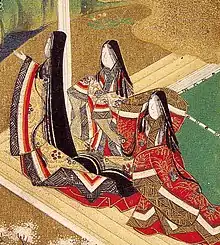Kosode
A kosode (小袖, lit., "small sleeves") is a type of short-sleeved, kimono-style garment that was traditionally worn in Japan until the latter years of the Edo period.



History
Originating in the Heian period as an undergarment for both men and women, the kosode was a plain white, often silk garment worn directly next to the skin. Both men and women layered, wrap-fronted, wide-sleeved robes on top of the kosode, with the style of layering worn by women of the Imperial Japanese court – known as jūnihitoe, literally "twelve layers" – featuring a greater number of robes than were seen on men. The kosode would also be worn as sleeping wear.
Following dress edicts designed to decrease the number of layered garments worn at court, the kosode gradually became outerwear from roughly the Kamakura period onwards. Styles of wearing the kosode – such as layering two kosode and wearing the uppermost robe stripped off from the shoulders – became popular, alongside the gradual development of kosode decoration techniques developing.
The kosode's proportions – a wide body and comparatively narrow sleeves – gradually evened out over time, before coming to resemble those of a modern kimono around the Edo period. The sleeves on some women's kosode also got longer and began to detach from the body below the shoulder, a style allowing the obi to become wider over time.
Parts
The parts of a kosode are roughly similar to those of a kimono, with the only major differences being the proportions of each aspect in comparison to those of a modern kimono.
- Sode (袖) – lit., "sleeve" – the sleeves of a kosode were comparatively short in both length and width, being for the most part attached to the body down the entire length, with a somewhat rounded edge below the wrist opening of each sleeve.
- Eri (襟) – lit., "collar" – the collar of the kosode was much wider than is seen on modern kimono, and was also relatively longer, forming a longer, shallower angle along the okumi.
- Migoro (身頃) – lit., "body" - the body panels for the kosode were much wider in proportion, creating a distinctive dropped-shoulder appearance.
- Okumi (袵) – the overlapping front panels. The okumi was far narrower than the okumi on modern kimono; this, combined with the length of the collar, gave the kosode a sloping, low-waisted appearance.
Gallery
 Kosode with yūzen dyework inside fan and snowflake shapes, 1700s, Ishikawa Prefectural Museum of Traditional Arts and Crafts
Kosode with yūzen dyework inside fan and snowflake shapes, 1700s, Ishikawa Prefectural Museum of Traditional Arts and Crafts Kosode for a woman, late 18th century, Honolulu Museum of Art
Kosode for a woman, late 18th century, Honolulu Museum of Art_with_Mandarin_Orange_Tree_and_Auspicious_Characters_MET_2002.325.jpg.webp) Kosode with Mandarin orange tree design and auspicious characters, late 18th century, Metropolitan Museum of Art
Kosode with Mandarin orange tree design and auspicious characters, late 18th century, Metropolitan Museum of Art Kosode for a woman with design inspired by Eight Views of Ōmi, 1780–1820, Khalili Collection of Kimono
Kosode for a woman with design inspired by Eight Views of Ōmi, 1780–1820, Khalili Collection of Kimono Kosode for a woman showing flowers on rafts, late 19th century, Khalili Collection of Kimono
Kosode for a woman showing flowers on rafts, late 19th century, Khalili Collection of Kimono
References
- Gluckman, Dale Carolyn, and Sharon Sadako Takeda, eds. When Art Became Fashion: Kosode in Edo-Period Japan. New York: Weatherhill, 1992.
- Kennedy, Alan. Japanese Costume: History and Tradition. New York: Rizzoli, 1990.
- Kosode: 16th–19th Century Textiles from the Nomura Collection. New York: Kodansha International, 1985.
External links
- Momoyama, Japanese Art in the Age of Grandeur, an exhibition catalog from The Metropolitan Museum of Art (fully available online as PDF), which contains material on Kosode
- Tokyo National Museum – an example of period clothing, including Kosode.
- The Tale of Genji Costume Museum – Includes period clothing, including Kosode.
- Kosode Made Simple
- Kyoto National Museum
